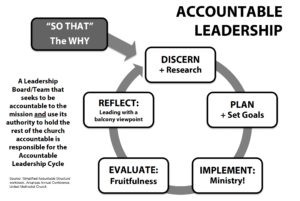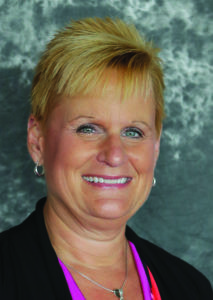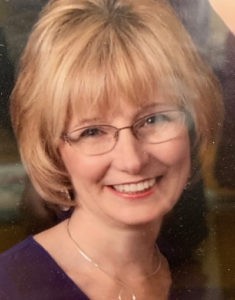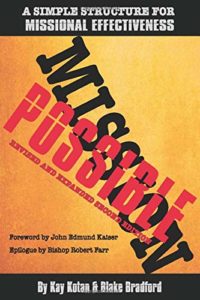If there’s an aspect of church life that United Methodists love more than a potluck supper, it’s structure. After all, John Wesley — who imbibed structure as a means of discipleship from his mother, Susanna — founded the Methodist movement using structures such as class meetings and bands in which Christians helped one another live out Jesus’ teachings. Structure forms Methodism’s DNA.
Unfortunately, over the half-century of its existence, The United Methodist Church layered structure upon structure until the denomination’s framework became a stumbling block to its stated mission — “to make disciples of Jesus Christ for transformation of the world.”
The UMC’s global legislative body, the General Conference, loosened requirements for parallel structures, especially for small-membership churches, in the early 21st century. While welcomed as a relief for overburdened congregations, the strategy still didn’t work to accomplish the mission of making disciples. Structure was driving mission, rather than mission driving structure.
The United Methodist Church layered structure upon structure until the denomination’s framework became a stumbling block to its stated mission.
About 12 years ago, the Missouri Annual (regional) Conference developed a program for congregational vitality in large-membership churches called the Healthy Church Initiative. Later adapted for small-membership churches as well, the program “flipped the paradigm,” as one of its co-developers says, on how to organize a congregation to fulfill the UMC’s stated mission.
Over the past decade, the original single-board model has blossomed into what’s now known as the Simplified Accountable Structure.
Making mission possible
Simplified Accountable Structure, formerly known as the “One Board” or alternative structure model, is revolutionizing local church mission and ministry, said one of its original developers, Kay Kotan, a professional certified coach and co-author with Blake Bradford of the book Mission Possible, which has become a guidebook for the movement.
 “As part of the Healthy Church process, we found that the traditional United Methodist structure often got in the way of churches living out their mission,” said Kotan, a fourth-generation Methodist who has been a consultant and coach for 20 years. “We were finding the same obstacles from church to church.”
“As part of the Healthy Church process, we found that the traditional United Methodist structure often got in the way of churches living out their mission,” said Kotan, a fourth-generation Methodist who has been a consultant and coach for 20 years. “We were finding the same obstacles from church to church.”
Simplified Accountable Structure has taken years to develop for one reason, said Kotan: “It’s hard to figure out how to live out a simplified structure with accountability because of what’s required in the Book of Discipline.” (The Book of Discipline is United Methodism’s 900-page compendium of rules and policies for the denomination).
Moving beyond Missouri, the Simplified Accountable Structure has spread to other conferences such as the Susquehanna (central Pennsylvania) and Arkansas, North Georgia, Indiana, Virginia, Great Plains (Kansas and Nebraska), North Texas, Oklahoma, Illinois Great Rivers (central and southern Illinois) and Western North Carolina conferences, as well as individual churches elsewhere.
How it works
Simplified Accountable Structure has arisen from a portion of the Book of Discipline that states, “When the membership size, program scope, mission resources, or other circumstances so require, the (local church) may, in consultation with and upon the approval of the district superintendent, modify the organizational plans.”
Although this section was intended originally to aid small-membership congregations that don’t have enough members to fill a traditional leadership roster, large-membership churches have embraced the model often for one outstanding reason: these church leaders recognized the efficiency and effectiveness in such a leadership model.

Kay Kotan
While the model brings greater operational efficiency because of fewer church meetings, Kotan said she sees its ultimate purpose to be its missional and strategic focus.
Currently, United Methodist leaders often are chosen for their vocational skills such as corporate board experience, professional training or technical prowess. Instead, Simplified Accountable stresses selecting spiritually mature disciples with the ability to discern and communicate God’s mission for the congregation, Kotan explained.
Through guiding principles and moving from the role of management to governance, the Simplified Accountable model aims to reduce duplication of effort and micro-managing as well.
“We don’t talk about replacing the dishwasher or what colors to paint the church parlor in leadership meetings,” Kotan said. “We empower a ministry team to complete a project.”
As an example, Kotan cited one of the required United Methodist administrative bodies, a board of trustees. Typically this board has been made up of people with experience in building trades who maintain a congregation’s physical plant. Under the Simplified Accountable Structure, Kotan said, the traditional trustee function of building and grounds maintenance becomes the work of a Building Maintenance ministry team.
The overall alignment of all assets with the mission — along with generative, and strategic work— is under the governance responsibility of the simplified, accountable leadership team, “stewards of the church’s assets” who think strategically about building needs and then authorize the pastor to set up teams to complete necessary tasks.
‘A living organism’
Jan Hughes, lead pastor of 800-member Aldersgate United Methodist Church in Mechanicsburg, Pa., has been teaching and coaching the Simplified, Accountable Structure in the Susquehanna Annual Conference for about 10 years. As a Simplified Accountable trainer and coach, she has watched the model’s evolution, starting when she was a trainee observing expert Paul Borden, author of the book Hit the Bullseye, introduce the model in her region.

Jan Hughes
“Those first 10 churches became role models for the experiment,” Hughes said. “Simplified Accountable is a living organism that we’re constantly evaluating.”
While the initial motivation for trying Simplified Accountable Structure often is to reduce the number of church meetings, “it’s so much more than that,” Hughes said.
“Churches say they want fewer meetings, but what they’re really yearning for is a solid and concerted vision,” she said. “That happens with simplified accountability.”
After seasons of discernment and equipping, the implementation process now typically takes a year before a congregation moves fully into simplified governance, Kotan said.
First a congregation’s new leaders form a leadership covenant identifying how they will do their governance work together. The second primary foundational work in the first year is to develop a set of guiding principles.
Guiding principles set permission-giving policies and procedures that outline the responsibilities of the leadership board and the pastor as well as how to provide as much permission as possible for ministry teams to do their work without additional approvals within healthy boundaries. In essence, congregations in collaboration with their pastor set the vision, the board sets annual goals, and then the ministry team leaders set objectives (day-to-day ministries) based on the goals.
The board is accountable to Christ for the church accomplishing the mission. The pastor is accountable to the board for the vision and goals. Staff (paid and unpaid ministry leaders) are accountable to the pastor for the objectives.
Often met with resistance
Simplified Accountable Structure often meets with initial resistance, said Bill LaMora, senior pastor of First United Methodist Church in Rolla, Mo., where Sunday worship attendance averaged around 250 people pre-COVID-19.

Bill Lamora
“When I got here five years ago, the church had decided to go with the Simplified Accountable Structure but were hesitant to give the pastor hiring and firing authority,” LaMora said. “They let the pastor be in charge of day-to-day management, but the board wanted to be in charge of personnel, so we had to decide if we were willing to commit to the whole system before the model became effective.”
Kotan said First UMC-Rolla’s experience was precisely why a congregation must fully understand Simplified Accountable Structure before voting to adopt it.
“It feels like you’re losing your authority or your ability to guide the church, but instead you’re streamlining it,” said LaMora, a certified trainer in the model. “People have to understand up front what the roles are. The guiding principles document must say who does what and set clear boundaries.”
Kotan, Hughes and LaMora all stressed the collaborative nature of the Simplified Accountable Structure.
“The annual process begins with the board and pastor setting strategic ministry goals for the church, which we do in fellowship together,” LaMora explained. “The board holds the pastor accountable to the goals but doesn’t manage how we reach those goals on a day-to-day basis.”
“The board holds the pastor accountable to the goals but doesn’t manage how we reach those goals on a day-to-day basis.”
The other major shift in Simplified Accountable Structure is with the Nominations and Lay Leadership Development Committee. Its major responsibility is the development of future leaders, Kotan said. The board consists of a minimum of nine members, serving three-year terms in staggered classes, so there’s a constant need for new board members as well as ministry team leaders.
Hughes said her congregation holds a nine-week “leadership summit” to find leaders. Candidates start by praying for two weeks, asking God to discern whether they’re called to serve on the leadership board. Those who reach such a spiritual discernment then embark on a curriculum that includes reviewing case studies, doing field work with ministry projects, and determining personal spiritual assets such as their Enneagram numberss (a personality assessment tool).
“We must always be aware whether we have adequate representation to reflect the body of the church,” Hughes said. “God seems to provide the balance when we just worry about calling.”
Limited terms valued
Hughes and LaMora also emphasized the value of limited terms.
“Terms are a beautiful thing,” LaMora noted. “Three people with experience rotate off and new people come in, so we constantly see fresh faces, with fresh ideas. We’re looking for spiritually developed people, people who are excited about church, spiritually strong, and participating in their membership vows.” (Upon joining a United Methodist congregation, members vow to support the church with their prayers, presence, gifts, service and witness).
“Terms are a beautiful thing.”
Board members also must be willing to do the hard work of holding themselves and the pastor accountable for accomplishing the church’s strategic goals.
“A board needs to be courageous enough to say to a pastor, ‘Why aren’t we accomplishing our goals?’” LaMora said. “Leaders need to ask those questions, not blaming but in a collaborative way. If a pastor and ministry team aren’t willing to accomplish the vision, then board members must be brave enough to say it’s not the right setting for that pastor.”
Hughes and LaMora both said their experiences with Simplified Accountable Structure have been effective and satisfying when the model is followed precisely.
“This is so much better than the old system,” Hughes said. “We went from ministry silos to all talking together. Before we talk about anything, we review our values and the vision God has given us. Simplified Accountable Structure is a lot of work for a pastor, but it’s much more fruitful work. It’s absolutely life-giving.”
Tested by coronavirus
LaMora said the Simplified Accountable Structure “really saved” his church when the coronavirus pandemic hit.
“When COVID hit, I said, ‘This is beyond me,’” LaMora said. “The board created COVID rules about when we would meet, such as when we would slide back and forth between in-person and virtual gatherings. It was such a compact, streamlined way to process the governance.”
 Hughes suggested congregations interested in Simplified Accountable Structure first read Kotan’s book, Mission Possible and John Kaiser’s book Winning on Purpose for introduction into the ideas behind the model.
Hughes suggested congregations interested in Simplified Accountable Structure first read Kotan’s book, Mission Possible and John Kaiser’s book Winning on Purpose for introduction into the ideas behind the model.
“We are better able to do kingdom work when we are structured to do ministry and allow God’s vision to drive us,” Hughes said.
LaMora cautioned that the model isn’t a magic formula to create congregational vitality.
“Simplified Accountable Structure isn’t for all churches,” LaMora said. “A congregation needs to discern and decide if it’s willing to embrace the model completely; if you half-do it, it always fails. You have to engage and commit to it.”
Kotan agreed with LaMora’s assessment. “This is exactly why it is no longer referred to as only a simplified structure, one board, or single board model. It is a simplified, accountable structure. Without embracing accountable leadership, it will indeed fail.”
Cynthia B. Astle is a veteran journalist who has covered the worldwide United Methodist Church at all levels for more than 30 years. She serves as editor of United Methodist Insight, an online journal she founded in 2011.


